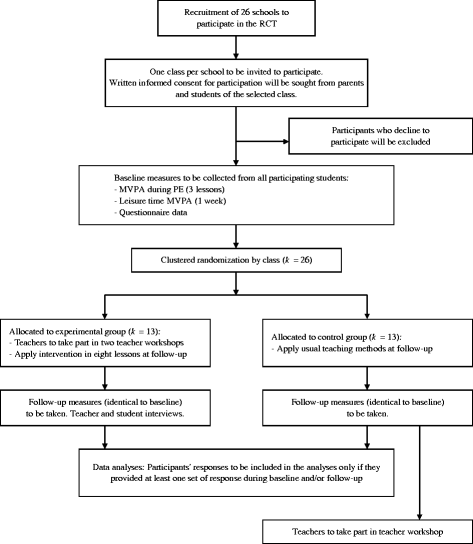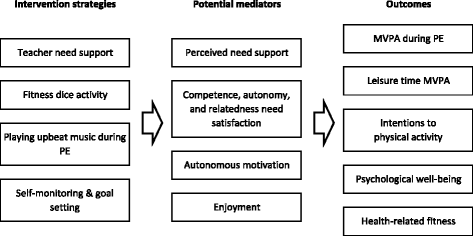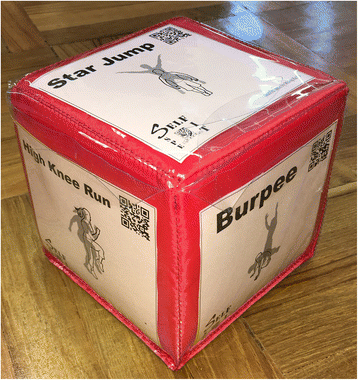Increasing students' physical activity during school physical education: rationale and protocol for the SELF-FIT cluster randomized controlled trial
- PMID: 28697797
- PMCID: PMC5505035
- DOI: 10.1186/s12889-017-4553-8
Increasing students' physical activity during school physical education: rationale and protocol for the SELF-FIT cluster randomized controlled trial
Erratum in
-
Erratum to: BMC Public Health, Vol. 18.BMC Public Health. 2017 Sep 22;17(1):736. doi: 10.1186/s12889-017-4709-6. BMC Public Health. 2017. PMID: 28938882 Free PMC article. No abstract available.
Abstract
Background: The Self-determined Exercise and Learning For FITness (SELF-FIT) is a multi-component school-based intervention based on tenets of self-determination theory. SELF-FIT aims to increase students' moderate-to-vigorous physical activity (MVPA) during physical education lessons, and enhance their autonomous motivation towards fitness activities. Using a cluster randomized controlled trial, we aim to examine the effects of the intervention on students' MVPA during school physical education.
Methods: Secondary 2 students (approximately aged 14 years) from 26 classes in 26 different schools will be recruited. After baseline assessments, students will be randomized into either the experimental group or wait-list control group using a matched-pair randomization. Teachers allocated to the experimental group will attend two half-day workshops and deliver the SELF-FIT intervention for 8 weeks. The main intervention components include training teachers to teach in more need supportive ways, and conducting fitness exercises using a fitness dice with interchangeable faces. Other motivational components, such as playing music during classes, are also included. The primary outcome of the trial is students' MVPA during PE lessons. Secondary outcomes include students' leisure-time MVPA, perceived need support from teachers, need satisfaction, autonomous motivation towards physical education, intention to engage in physical activity, psychological well-being, and health-related fitness (cardiorespiratory and muscular fitness). Quantitative data will be analyzed using multilevel modeling approaches. Focus group interviews will also be conducted to assess students' perceptions of the intervention.
Discussion: The SELF-FIT intervention has been designed to improve students' health and well-being by using high-intensity activities in classes delivered by teachers who have been trained to be autonomy needs supportive. If successful, scalable interventions based on SELF-FIT could be applied in physical education at large.
Trial registration: The trial is registered at the Australia New Zealand Clinical Trial Registry (Trial ID: ACTRN12615000633583 ; date of registration: 18 June 2015).
Keywords: Basic psychological needs; Fitness dice; Health-related fitness; Moderate-to-vigorous physical activity; Physical education; School-based intervention; Self-determination theory.
Conflict of interest statement
Ethics approval and consent to participate
The protocol of the study was reviewed and approved by the Joint Chinese University of Hong Kong – New Territories East Cluster Clinical Research Ethics Committee (Ref: 2014.114). Written informed consent will be obtained from participating teachers, students, and students’ parents prior to the start of the trial.
Consent for publication
Not applicable.
Competing interests
The authors declare that they have no competing interests.
Publisher’s Note
Springer Nature remains neutral with regard to jurisdictional claims in published maps and institutional affiliations.
Figures
References
-
- Chow BC, TL MK, Louie L. Children's physical activity and environmental influences during elementary school physical education. J Teach Phys Educ. 2008;27:38–50. doi: 10.1123/jtpe.27.1.38. - DOI
-
- Ha AS, Macdonald D, BOH P. Physical activity in the lives of Hong Kong Chinese children. Sport Educ Soc. 2010;15:331–346. doi: 10.1080/13573322.2010.493313. - DOI
Publication types
MeSH terms
Associated data
LinkOut - more resources
Full Text Sources
Other Literature Sources
Medical




